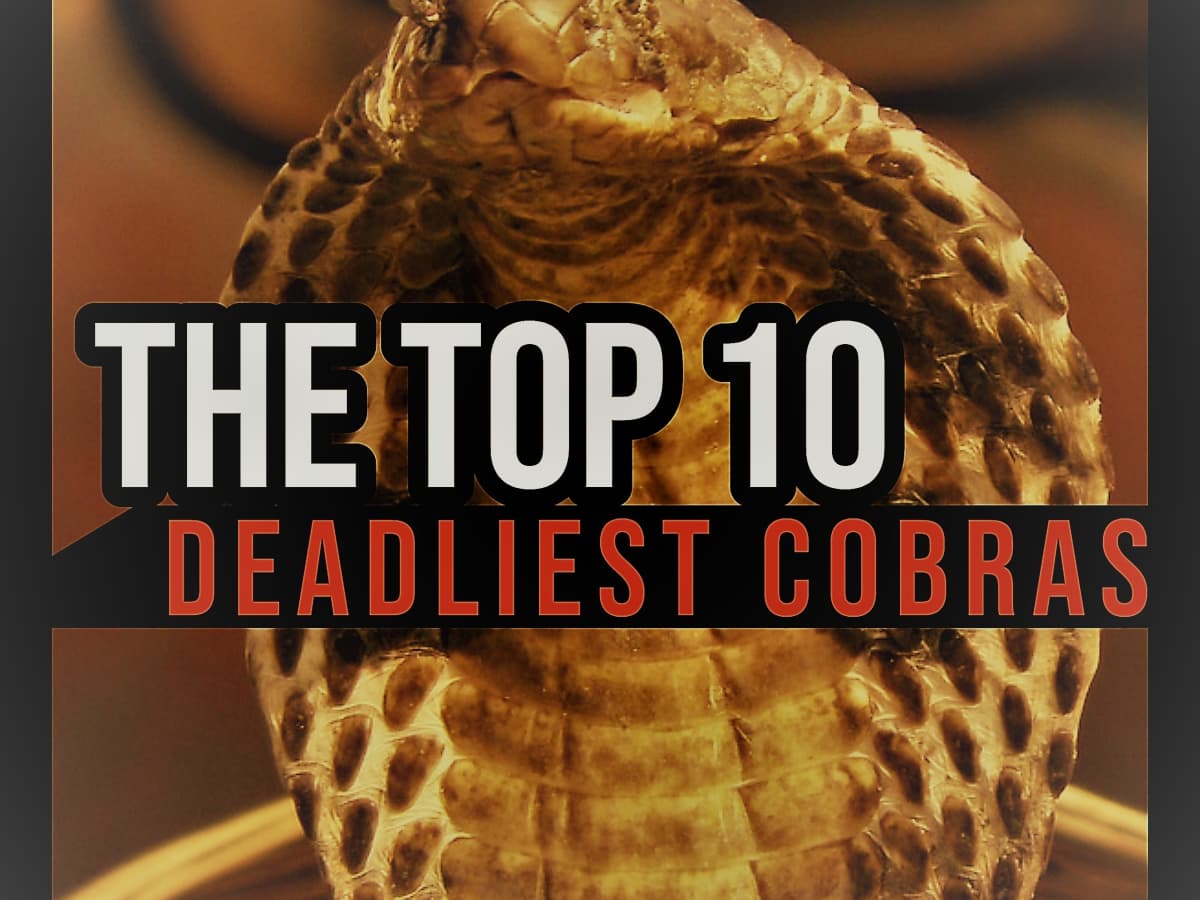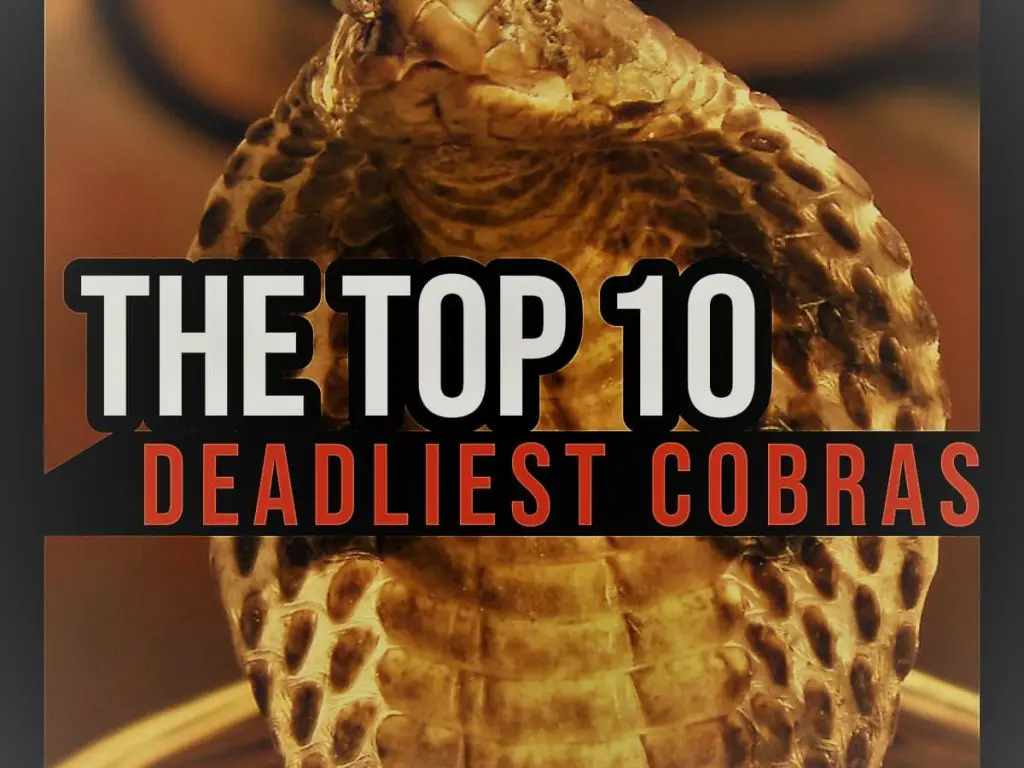Cobras, one of the deadliest snake species in the world, have always fascinated us with their hypnotic charm and deadly venom. Their ability to strike with lightning speed has made them a subject of fear and admiration. In this article, we will take a countdown of the top 10 deadliest cobras in the world and explore their unique characteristics that make them so lethal.
From the king cobra to the black-necked spitting cobra, each of these snakes has its own distinct features that make them a force to be reckoned with. Join us as we delve into the world of these fascinating creatures and learn about their deadly venom and the dangers that come with encountering them in the wild.
Discover the top 10 deadliest cobras in the world in this thrilling countdown. From the notorious king cobra to the lesser-known forest cobra, learn about their venomous bites and aggressive behavior. Brace yourself for this fascinating journey through the world of these deadly snakes.

Top 10 Deadliest Cobras in the World: a Countdown
Cobras are one of the most venomous snakes in the world, and their bite can be fatal if not treated promptly. In this article, we will count down the top 10 deadliest cobras in the world and explore their characteristics, habitats, and venom.
10. Cape Cobra
The Cape cobra is a highly venomous species found in southern Africa. It is known for its aggressive behavior and can deliver a lethal bite within minutes. The venom of the Cape cobra attacks the nervous system, causing paralysis and respiratory failure.
The Cape cobra grows up to 6 feet in length and has a distinctive hood that it raises when threatened. It feeds primarily on rodents, birds, and other snakes.
| Benefits | VS |
|---|---|
| Helps control rodent populations | Highly venomous and aggressive |
| Important role in the ecosystem | Can be fatal if not treated promptly |
9. Forest Cobra
The forest cobra is a large and highly venomous snake found in central and western Africa. It is known for its speed and agility and can deliver a lethal bite within minutes. The venom of the forest cobra attacks the nervous system, causing paralysis and respiratory failure.
The forest cobra grows up to 10 feet in length and has a dark brown or black coloration. It feeds primarily on rodents, birds, and other snakes.
- Fast and agile
- Highly venomous and aggressive
- Important role in the ecosystem
- Can be fatal if not treated promptly
8. Philippine Cobra
The Philippine cobra is a highly venomous species found in the Philippines. It is known for its deadly neurotoxin, which can cause respiratory failure and death within minutes. The venom of the Philippine cobra attacks the nervous system, causing paralysis and respiratory failure.
The Philippine cobra grows up to 5 feet in length and has a distinctive hood that it raises when threatened. It feeds primarily on rodents, birds, and other snakes.
- Deadly neurotoxin
- Distinctive hood
- Can be fatal if not treated promptly
7. Caspian Cobra
The Caspian cobra is a highly venomous species found in Central Asia and the Middle East. It is known for its aggressive behavior and can deliver a lethal bite within minutes. The venom of the Caspian cobra attacks the nervous system, causing paralysis and respiratory failure.
The Caspian cobra grows up to 6 feet in length and has a brown or gray coloration. It feeds primarily on rodents, birds, and other snakes.
| Benefits | VS |
|---|---|
| Helps control rodent populations | Highly venomous and aggressive |
| Important role in the ecosystem | Can be fatal if not treated promptly |
6. Black-Necked Spitting Cobra
The black-necked spitting cobra is a highly venomous species found in sub-Saharan Africa. It is known for its ability to spit venom up to 8 feet, causing blindness and severe pain. The venom of the black-necked spitting cobra attacks the nervous system, causing paralysis and respiratory failure.
The black-necked spitting cobra grows up to 5 feet in length and has a black or dark brown coloration. It feeds primarily on rodents, birds, and other snakes.
- Ability to spit venom
- Highly venomous and aggressive
- Can be fatal if not treated promptly
5. King Cobra
The king cobra is one of the largest and most venomous snakes in the world. It is found in Southeast Asia and is known for its deadly neurotoxin, which can cause respiratory failure and death within minutes. The venom of the king cobra attacks the nervous system, causing paralysis and respiratory failure.
The king cobra grows up to 18 feet in length and has a distinctive hood that it raises when threatened. It feeds primarily on rodents, birds, and other snakes.
| Benefits | VS |
|---|---|
| Helps control rodent populations | Highly venomous and aggressive |
| Important role in the ecosystem | Can be fatal if not treated promptly |
4. Monocled Cobra
The monocled cobra is a highly venomous species found in Southeast Asia and India. It is known for its deadly neurotoxin, which can cause respiratory failure and death within minutes. The venom of the monocled cobra attacks the nervous system, causing paralysis and respiratory failure.
The monocled cobra grows up to 6 feet in length and has a distinctive monocle-shaped pattern on its hood. It feeds primarily on rodents, birds, and other snakes.
- Distinctive monocle-shaped pattern on its hood
- Highly venomous and aggressive
- Can be fatal if not treated promptly
3. Indian Cobra
The Indian cobra is a highly venomous species found in India and Southeast Asia. It is known for its deadly neurotoxin, which can cause respiratory failure and death within minutes. The venom of the Indian cobra attacks the nervous system, causing paralysis and respiratory failure.
The Indian cobra grows up to 6 feet in length and has a distinctive hood that it raises when threatened. It feeds primarily on rodents, birds, and other snakes.
| Benefits | VS |
|---|---|
| Helps control rodent populations | Highly venomous and aggressive |
| Important role in the ecosystem | Can be fatal if not treated promptly |
2. Black Mamba
The black mamba is one of the most venomous snakes in the world, found in sub-Saharan Africa. It is known for its speed and aggression and can deliver a lethal bite within minutes. The venom of the black mamba attacks the nervous system, causing paralysis and respiratory failure.
The black mamba grows up to 14 feet in length and has a gray or olive-green coloration. It feeds primarily on rodents, birds, and other snakes.
- Fast and aggressive
- Highly venomous
- Can be fatal if not treated promptly
1. Inland Taipan
The inland taipan, also known as the “fierce snake,” is the most venomous snake in the world. It is found in Australia and is known for its deadly neurotoxin, which can cause respiratory failure and death within minutes. The venom of the inland taipan attacks the nervous system, causing paralysis and respiratory failure.
The inland taipan grows up to 8 feet in length and has a light brown or olive coloration. It feeds primarily on small mammals.
- Most venomous snake in the world
- Deadly neurotoxin
- Can be fatal if not treated promptly
In conclusion, cobras are some of the most dangerous snakes in the world, and their venom can cause serious harm to humans and animals alike. Knowing about the deadliest cobras is essential for those living in areas where these snakes are found, and it is vital to take necessary precautions to avoid encountering them.
Frequently Asked Questions
Here are some of the most commonly asked questions about the Top 10 Deadliest Cobras in the World: a Countdown.
What is the deadliest cobra in the world?
The King Cobra is widely considered to be the deadliest cobra in the world. It is also the longest venomous snake in the world, reaching up to 18 feet in length. The venom of the King Cobra is highly toxic and can cause respiratory failure, leading to death in as little as 30 minutes.
Despite its reputation, the King Cobra is not an aggressive snake and will generally only attack if provoked or cornered. However, its large size and deadly venom make it a formidable predator that should be treated with caution.
What is the difference between a cobra and a viper?
Cobras and vipers are both types of venomous snakes, but there are some key differences between them. Cobras are part of the Elapidae family of snakes, which includes other venomous species such as mambas and coral snakes. Vipers, on the other hand, are part of the Viperidae family and include snakes such as rattlesnakes and adders.
One of the main differences between these two groups is the way their venom is delivered. Cobras have short, fixed fangs that inject venom into their prey, while vipers have long, hinged fangs that can fold back when not in use. This allows vipers to deliver a larger amount of venom with each bite.
What is the most venomous cobra on the list?
The Cape Cobra, also known as the Yellow Cobra, is considered to be the most venomous cobra on this list. Its venom is highly neurotoxic and can cause paralysis and respiratory failure in its victims. The Cape Cobra is also known for its aggressive behavior and will often stand its ground and hiss loudly when threatened.
Despite its potency, the Cape Cobra is not responsible for many human fatalities as it tends to avoid contact with people. However, bites from this snake can be fatal if medical treatment is not sought immediately.
How do you avoid being bitten by a cobra?
The best way to avoid being bitten by a cobra is to stay away from areas where they are known to live. Cobras are most commonly found in the tropical regions of Asia and Africa, where they inhabit forests, grasslands, and agricultural areas.
If you do encounter a cobra, it is important to stay calm and give the snake plenty of space. Do not attempt to handle or capture the snake, as this is when most bites occur. If you are bitten, seek medical attention immediately.
What should you do if you are bitten by a cobra?
If you are bitten by a cobra, it is important to seek medical attention as soon as possible. Cobra venom can cause a range of symptoms, including pain, swelling, nausea, and difficulty breathing. In severe cases, it can lead to paralysis and even death.
While waiting for medical help to arrive, it is important to stay calm and keep the affected limb immobilized. Do not attempt to suck out the venom or apply a tourniquet, as these methods are ineffective and can actually make the situation worse.
In conclusion, cobras are among the most dangerous snakes in the world, and their venom can be fatal to humans. The top 10 deadliest cobras in the world are a force to be reckoned with, ranging from the black mamba to the king cobra and more. These snakes have a powerful bite and lethal venom that can cause paralysis, respiratory failure, and even death.
It is important to note that these snakes are not inherently evil or aggressive, and they only attack humans when they feel threatened or cornered. Therefore, it is crucial to avoid provoking them and to seek professional help if you encounter one in the wild.
In conclusion, while these snakes may be deadly, they are also fascinating creatures that play an important role in our ecosystem. By respecting their space and learning more about their behavior, we can coexist with these magnificent creatures in a safe and responsible manner.


